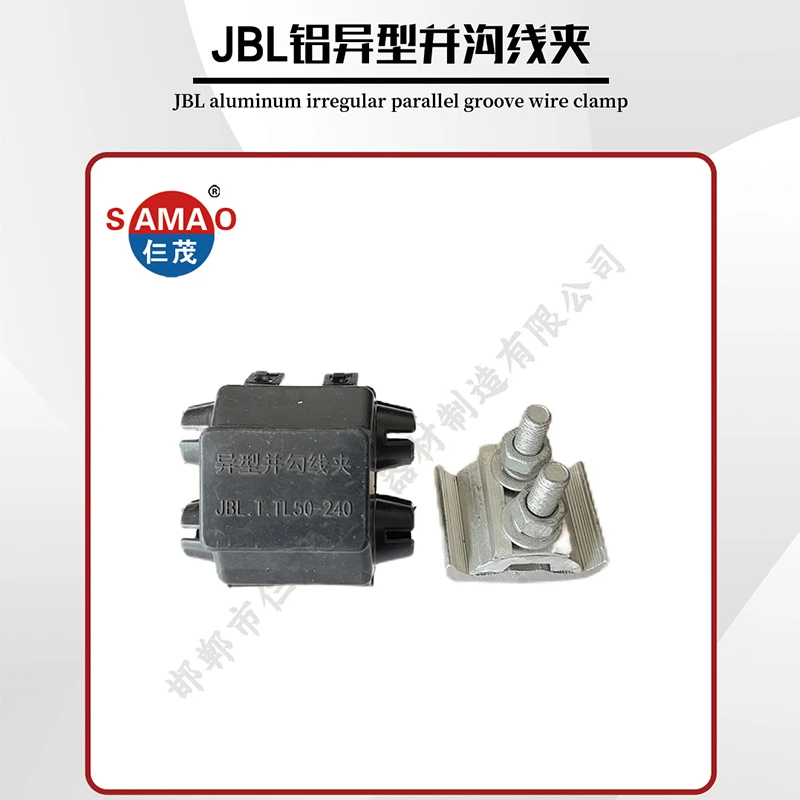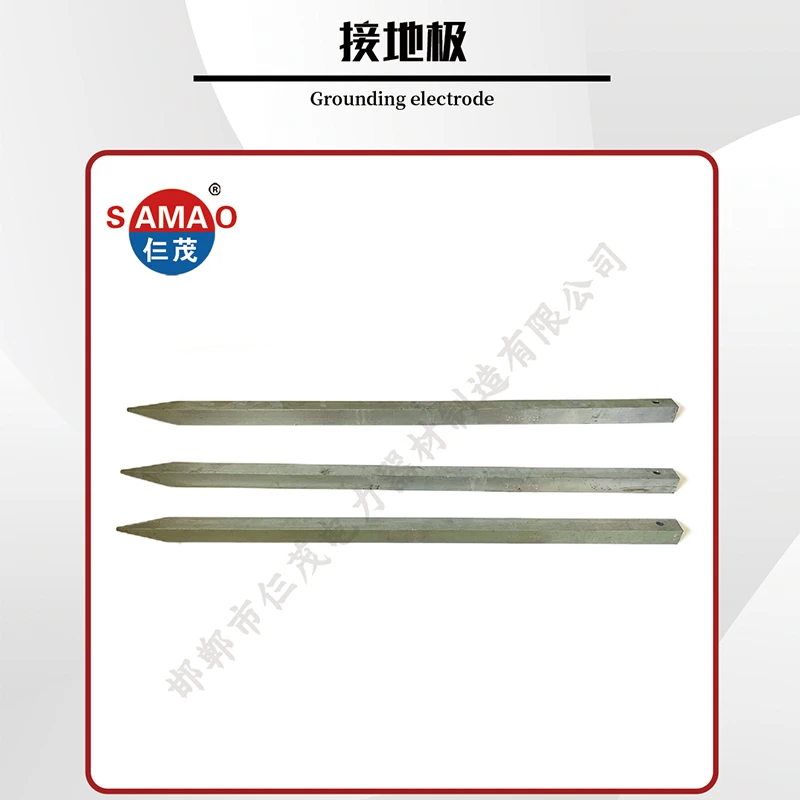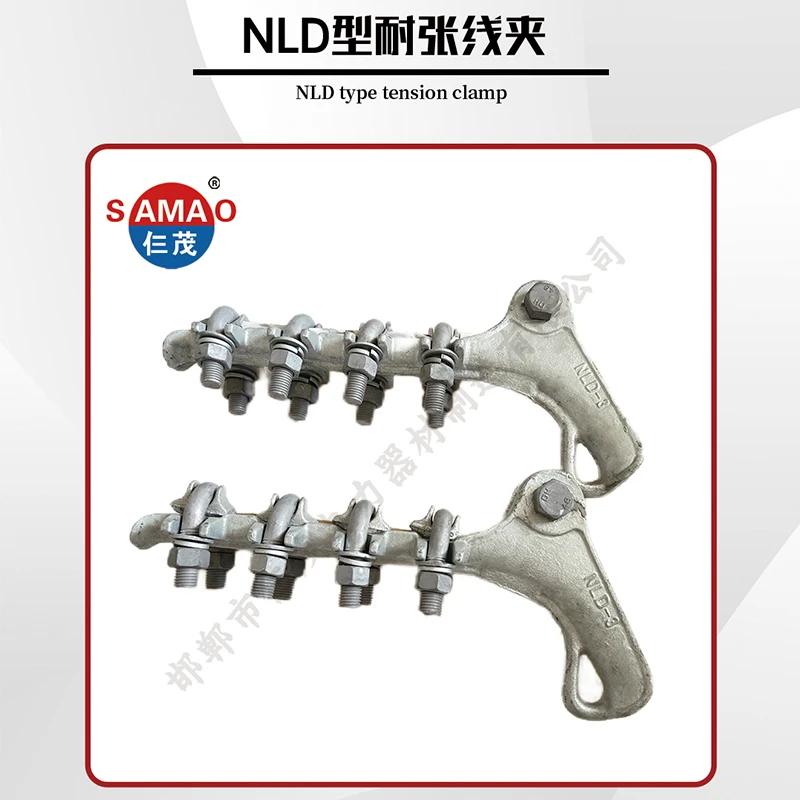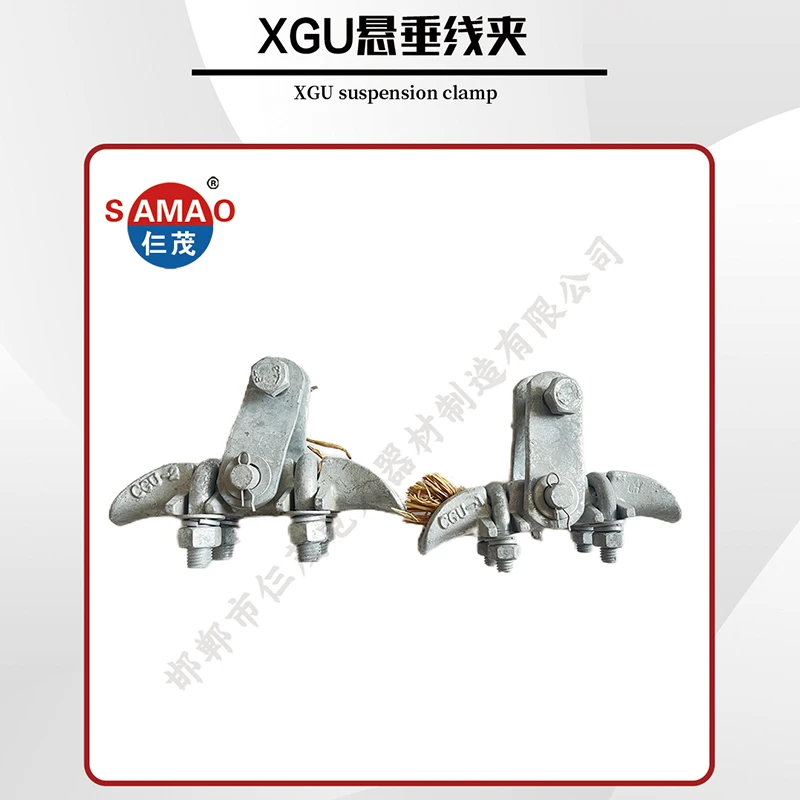Durable Parallel Groove Clamps | Secure Electrical Connectors
Understanding the Crucial Role of Parallel Groove Clamps in Modern Infrastructure
The backbone of efficient power transmission and distribution networks, as well as critical grounding systems in various industrial applications, hinges significantly on the reliability of electrical connectors. Among these, the parallel groove clamp stands out as a fundamental component. This versatile fitting is meticulously engineered to establish secure, low-resistance connections between two parallel conductors, primarily in overhead power lines, substations, and earthing grids. Its design, characterized by parallel grooves that precisely accommodate conductors, ensures optimal contact area, thereby minimizing electrical resistance and preventing localized heating—a common cause of power losses and system failures. The selection of the appropriate parallel groove clamp is not merely a technical decision but a strategic investment that directly impacts system integrity, operational efficiency, and long-term cost-effectiveness. In an era where demand for reliable power and robust infrastructure is perpetually escalating, understanding the nuanced aspects of these critical connectors becomes paramount for engineers, procurement specialists, and project managers across the energy, industrial, and telecommunications sectors. This comprehensive guide delves into the intricate details of parallel groove clamps, exploring their technological evolution, manufacturing precision, diverse applications, and the stringent quality standards that define their performance, aiming to provide a holistic perspective for informed decision-making in high-stakes environments.
Beyond their primary function of electrical connectivity, parallel groove clamps play a vital role in ensuring mechanical stability, particularly in environments exposed to extreme weather conditions, vibrations, and thermal cycling. The robust construction materials, often high-strength aluminum alloy or copper, coupled with advanced manufacturing processes, enable these clamps to withstand significant tensile loads and maintain their structural integrity over decades of service. Furthermore, specialized variants, such as bimetallic parallel connectors, are indispensable when joining dissimilar conductors (e.g., aluminum to copper), effectively preventing galvanic corrosion—a critical issue that can severely degrade connection quality and lead to premature system failure. The emphasis on minimizing electrical resistance and preventing hotspot formation not only enhances energy efficiency but also significantly reduces the risk of arc faults and related hazards, thereby bolstering safety protocols within operational sites. As the global push towards smart grids and renewable energy integration accelerates, the demand for highly reliable, durable, and environmentally resilient parallel groove clamps continues to surge, underscoring their irreplaceable position in the modern electrical infrastructure landscape. This article will further elaborate on the specific technical parameters, industry standards, and application-specific considerations that guide the optimal selection and deployment of these essential components, providing a detailed roadmap for industry professionals navigating complex electrical system designs.
Industry Trends and Market Dynamics for Parallel Groove Connectors
The global market for parallel groove clamps is witnessing significant dynamism, driven by several overarching industry trends that underscore their increasing demand and evolving technical specifications. A primary driver is the rapid expansion and modernization of power transmission and distribution networks worldwide. Emerging economies, in particular, are investing heavily in new grid infrastructure to meet escalating energy demands, while developed nations are focusing on upgrading aging grids to enhance reliability, integrate renewable energy sources, and facilitate the transition to smart grid technologies. This global infrastructure push directly translates into a heightened requirement for reliable electrical connectors, including robust parallel groove clamp solutions capable of withstanding diverse environmental stresses and ensuring long-term operational integrity. Furthermore, the burgeoning renewable energy sector, encompassing large-scale solar farms and wind power installations, relies extensively on these clamps for efficient power evacuation and grid interconnection. The unique challenges posed by intermittent generation and remote locations in renewable energy projects necessitate connectors with superior performance characteristics, including enhanced corrosion resistance and thermal stability.
Technological advancements are also shaping the market, with manufacturers continually innovating to improve clamp performance, ease of installation, and cost-effectiveness. Key innovations include the development of bimetallic parallel connectors that effectively manage galvanic corrosion between dissimilar conductors (e.g., aluminum and copper), pre-filled inhibitor compounds to prevent oxidation and ensure stable electrical contact, and designs optimized for specific conductor types and environmental conditions. The increasing emphasis on sustainability and energy efficiency is prompting a shift towards clamps with lower resistance values, thereby reducing power losses during transmission and contributing to overall grid efficiency. Regulatory frameworks and international standards (such as IEC 61284, ANSI C119.4, and ASTM B230) are becoming more stringent, compelling manufacturers to adhere to higher quality and safety benchmarks, which in turn influences product design, material selection, and testing protocols. Geographically, while Asia-Pacific continues to dominate the market due to massive infrastructure projects in countries like China and India, significant growth is also observed in North America and Europe, driven by grid modernization initiatives and the integration of distributed energy resources. Understanding these market dynamics, including the competitive landscape and the influence of raw material prices (aluminum and copper), is crucial for stakeholders seeking to optimize procurement strategies and forecast future demands for high-performance parallel groove clamps. This intricate interplay of infrastructure growth, technological innovation, and regulatory evolution defines the contemporary market for these essential electrical components, positioning them as critical enablers for future energy systems.
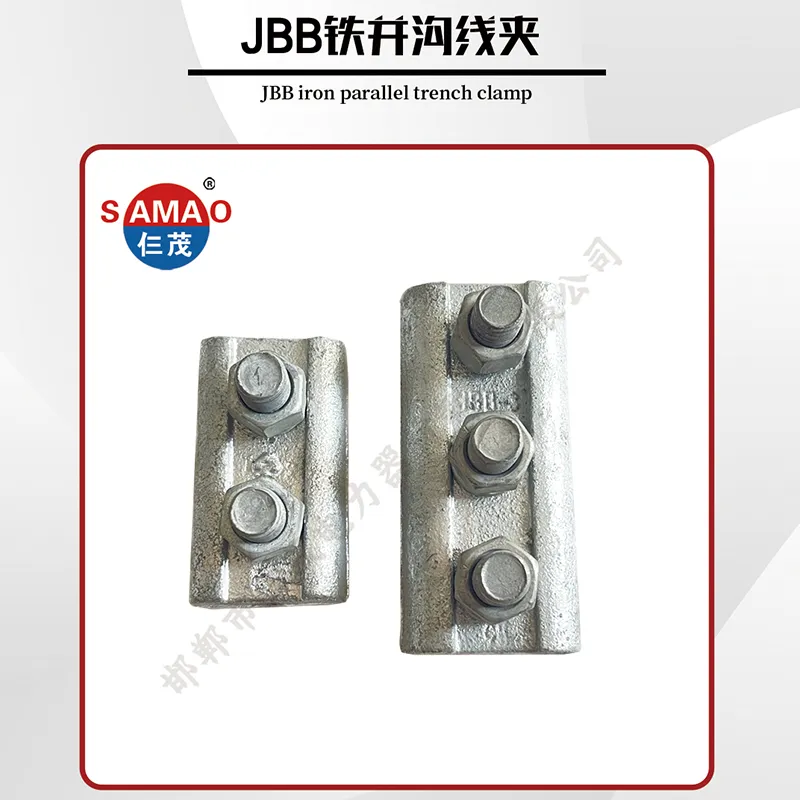
Technical Parameters and Specifications of Parallel Groove Clamps
The performance and suitability of a parallel groove clamp are fundamentally defined by a comprehensive set of technical parameters and specifications. These parameters are critical for engineers to ensure compatibility with existing infrastructure, optimize system performance, and guarantee long-term reliability and safety. Key among these are the material composition, which typically includes high-strength aluminum alloys (like AlMgSi) for ACSR and all-aluminum conductors, or high-conductivity copper for copper conductors. Bimetallic versions, often an aluminum body with a copper insert, are essential for connecting dissimilar conductors, preventing detrimental galvanic corrosion by separating the two metals. The conductor range is another vital specification, indicating the cross-sectional area (in mm² or MCM) of the conductors that the clamp can securely accommodate. This range is crucial for ensuring proper mechanical grip and electrical contact. Rated voltage (kV) specifies the maximum voltage for which the clamp is designed, influencing insulation requirements and overall system safety. Furthermore, the current carrying capacity, usually expressed in Amperes, determines the maximum continuous current the clamp can safely conduct without exceeding specified temperature rises, directly impacting energy efficiency and preventing thermal overloads.
Mechanical strength is a paramount parameter, quantified by the clamp's tensile strength (kN), which indicates its ability to withstand mechanical forces, such as wind loads, ice loads, and vibrations, without deformation or failure. This is often tested according to standards like IEC 61284. Electrical resistance, typically measured in micro-ohms (µΩ), is a critical performance indicator; lower resistance signifies better conductivity and reduced power losses, directly contributing to energy efficiency and a lower parallel groove clamp price over its lifecycle due to reduced operational costs. Corrosion resistance, achieved through material selection and surface treatments (e.g., hot-dip galvanization for steel components, tin plating for copper), ensures the clamp’s longevity in harsh environmental conditions, including coastal areas, industrial zones, and regions with extreme temperatures. The creep resistance of the material, especially for aluminum alloys, is also significant, as it indicates the material's ability to resist slow deformation under continuous mechanical stress over time, preserving the integrity of the connection. Additionally, the installation torque specified by the manufacturer is vital for achieving the optimal clamping force without damaging the conductors or the clamp itself, ensuring a secure and lasting connection. Adherence to international standards such as ISO, ANSI, IEC, and ASTM is a fundamental requirement, validating the product's design, manufacturing quality, and performance against established benchmarks. Below is a detailed table summarizing typical technical parameters for various types of parallel groove clamps, illustrating the diverse specifications available to meet rigorous application demands.
| Parameter | Aluminum-Aluminum Clamp | Copper-Copper Clamp | Bimetallic (Al-Cu) Clamp |
|---|---|---|---|
| Material | High Strength Aluminum Alloy (e.g., AlMgSi) | High Conductivity Electrolytic Copper | Aluminum Body, Copper Insert (tin-plated) |
| Conductor Type Compatibility | AAAC, ACSR, AAC | Copper Wire, Copper Stranded | Aluminum to Copper |
| Conductor Range (mm²) | Typically 16mm² - 500mm² (various models) | Typically 10mm² - 300mm² (various models) | Al: 16-240mm² / Cu: 10-185mm² |
| Rated Voltage | Up to 35 kV (specific design for HV lines) | Low Voltage (LV) to Medium Voltage (MV) | Low Voltage (LV) to Medium Voltage (MV) |
| Electrical Resistance (µΩ) | Less than 20% of equivalent conductor length (e.g., < 50 µΩ for specific sizes) | Less than 10% of equivalent conductor length (e.g., < 30 µΩ for specific sizes) | Meeting specific thermal cycling criteria (e.g., < 80 µΩ initial) |
| Tensile Strength (kN) | Varies by size, e.g., 8 kN to 25 kN (meeting IEC 61284) | Varies by size, e.g., 5 kN to 20 kN | Varies by size, e.g., 6 kN to 22 kN |
| Corrosion Resistance | Excellent (Self-passivating aluminum oxide layer) | Very Good (Natural patina formation) | Very Good (Copper insert tin-plated, inhibitor compound applied) |
| Standards Met | IEC 61284, ANSI C119.4, BS EN 50483, ASTM B230 | IEC 61284, ANSI C119.4 | IEC 61284, ANSI C119.4 (especially regarding bimetallic connections) |
| Lifespan Expectancy | 30+ years under specified conditions | 30+ years under specified conditions | 25+ years with proper installation and inhibitor |
The Rigorous Manufacturing Process of Parallel Groove Clamps
The production of a high-quality parallel groove clamp is a testament to precision engineering, involving a multi-stage manufacturing process designed to meet the stringent demands of electrical infrastructure. This process begins with the careful selection of raw materials, primarily high-strength aluminum alloys (e.g., A6061-T6, A6063-T6) or high-conductivity electrolytic copper. For bimetallic parallel connectors, the process integrates both aluminum for the main body and high-purity copper for the connecting insert, often tin-plated to enhance conductivity and corrosion resistance. The initial stage typically involves either casting or hot forging. Casting, often using gravity casting or low-pressure die casting, is employed for complex shapes, ensuring uniform material distribution and minimal internal stresses. Hot forging, on the other hand, is preferred for components requiring superior mechanical strength and ductility, as it refines the grain structure of the metal, leading to enhanced fatigue resistance and overall robustness. This choice of primary forming process depends heavily on the specific design requirements and the desired mechanical properties of the final product, directly impacting the parallel groove clamp price and its performance longevity.
Following the initial forming, the components undergo precise CNC machining. This stage is critical for achieving the exact dimensions of the parallel grooves, bolt holes, and other intricate features. CNC (Computer Numerical Control) machining ensures unparalleled accuracy and repeatability, which is paramount for creating a consistent, low-resistance electrical contact surface. Modern CNC machines can hold extremely tight tolerances, guaranteeing that each clamp precisely matches engineering specifications. After machining, parts typically undergo surface treatment to enhance durability and environmental resistance. For aluminum clamps, this might include passivation or anodizing to improve corrosion resistance. For steel bolts and nuts used in the assembly, hot-dip galvanization is standard, providing a robust zinc coating that offers superior protection against rust and atmospheric corrosion, critical for outdoor applications. In the case of bimetallic clamps, the copper inserts are meticulously tin-plated to prevent galvanic corrosion when in contact with aluminum conductors, further extending the lifespan of the connection.
The manufacturing process culminates in a series of rigorous quality control and testing standards to ensure that each parallel groove clamp meets or exceeds international benchmarks such as ISO 9001 for quality management systems, and product-specific standards like IEC 61284, ANSI C119.4, and ASTM B230. These tests include:
- Tensile Strength Testing: To verify the mechanical integrity and load-bearing capacity of the clamp, ensuring it can withstand severe environmental conditions without failure.
- Electrical Resistance Testing: Measuring the contact resistance to ensure minimal power loss and efficient current transfer, often through thermal cycling tests that simulate real-world thermal expansion and contraction.
- Corrosion Resistance Testing: Salt spray tests and other environmental chamber tests simulate harsh atmospheric conditions to assess the clamp's long-term durability.
- Temperature Rise Tests: To ensure the clamp does not overheat under rated current, verifying its current carrying capacity.
- Vibration Testing: Simulating the mechanical stresses induced by wind and other external factors to ensure the connection remains stable.
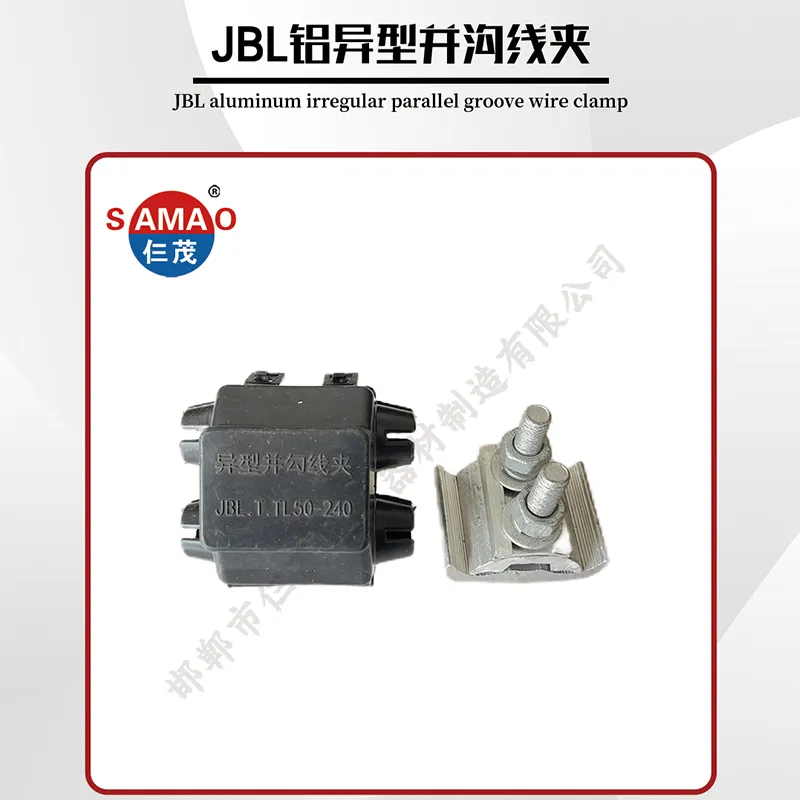
Diverse Application Scenarios and Operational Benefits
The ubiquitous nature of the parallel groove clamp stems from its adaptability and indispensable role across a multitude of critical industrial and infrastructural sectors. Primarily, these clamps are fundamental to the efficient operation of overhead power transmission and distribution lines, forming secure electrical connections between phase conductors or between phase conductors and tapping conductors. In high-voltage (HV) transmission lines, where massive amounts of power are transported over long distances, the reliability of every parallel connector is paramount to minimize energy losses and ensure grid stability. Similarly, in medium-voltage (MV) and low-voltage (LV) distribution networks, these clamps facilitate branching and tapping connections to supply power to residential, commercial, and industrial consumers. Their ability to maintain stable electrical contact under varying thermal loads and mechanical stresses, such as those induced by wind and ice, is a critical operational benefit, preventing costly outages and ensuring uninterrupted power supply. Beyond conventional power grids, parallel groove clamps are integral to the burgeoning renewable energy sector, including large-scale solar power plants and wind farms. Here, they are used to connect collector lines, substations, and grid interconnections, often in remote and environmentally challenging locations where extreme temperatures and corrosive atmospheres demand exceptionally durable and reliable connectors, thus influencing the parallel groove clamp price in these specialized applications.
The applications extend far beyond overhead lines. In industrial settings, particularly within the petrochemical, metallurgy, and mining industries, parallel groove clamps are extensively used for grounding systems and bonding applications. Effective grounding is crucial for personnel safety, equipment protection, and compliance with strict regulatory standards. These clamps ensure low-resistance paths for fault currents, dissipating energy safely into the earth. In large industrial complexes, given the presence of corrosive agents and high temperatures, the corrosion resistance and thermal stability of the clamps are significant advantages, guaranteeing system longevity and reducing maintenance frequency. Furthermore, in railway electrification projects, parallel groove clamps are used for connecting catenary wires and return current paths, where vibrations and dynamic loads necessitate highly robust and fatigue-resistant connections. In the telecommunications sector, they facilitate grounding connections for towers and equipment, ensuring signal integrity and protection against lightning strikes. Even in municipal infrastructure, such as water supply and drainage systems, where electrical equipment is common, these clamps provide reliable grounding for pumps, control panels, and other electrical components, demonstrating their versatility.
The operational benefits derived from utilizing high-quality parallel groove clamps are substantial and multifaceted. Firstly, their low electrical resistance significantly contributes to energy saving by minimizing resistive losses (I²R losses) along the conductor path. This translates into tangible operational cost reductions over the lifespan of the electrical system, directly impacting the total cost of ownership rather than just the initial parallel groove clamp price. Secondly, the robust mechanical design and high-quality materials ensure superior anti-corrosion performance, even in aggressive environments (e.g., coastal, industrial polluted areas). This property reduces the need for frequent inspections and maintenance, leading to substantial savings in labor and materials. Thirdly, the excellent thermal stability and secure clamping force prevent localized heating and hotspot formation, thereby mitigating the risk of component degradation, insulation breakdown, and potential fire hazards. This enhancement in safety is invaluable in any electrical installation. Lastly, the long operational lifespan, typically exceeding 25-30 years, minimizes the frequency of replacements, ensuring continuous operation and contributing to the overall reliability and resilience of the electrical infrastructure. These combined benefits underscore why the selection of a high-performance parallel groove clamp is a strategic decision for any project manager or engineer seeking to optimize both efficiency and safety in their electrical systems.
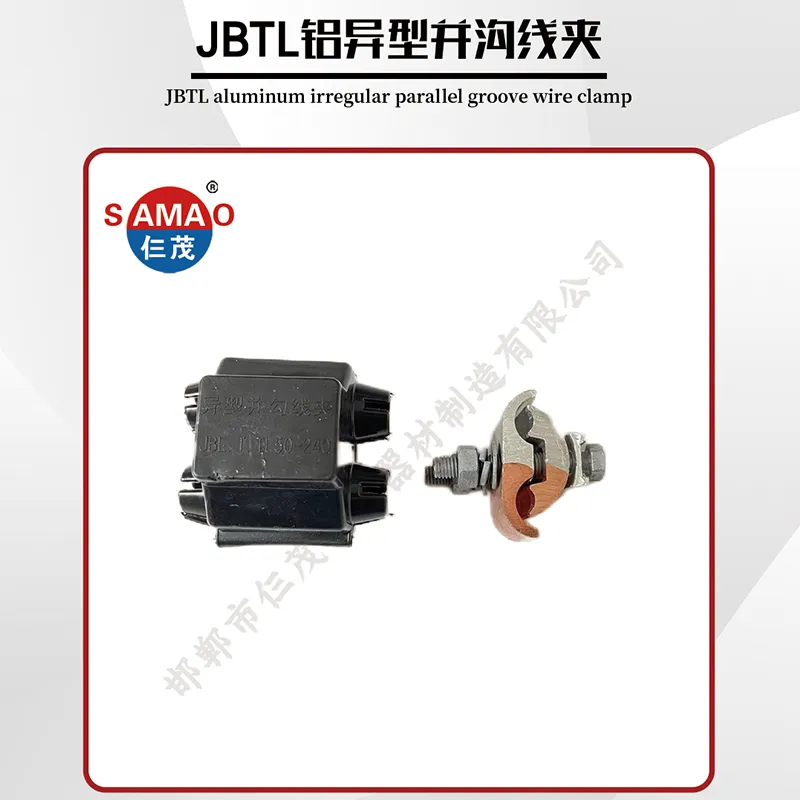
Technical Advantages of Advanced Parallel Groove Clamps and Connectors
The evolution of parallel groove clamp technology has introduced several advanced features that significantly enhance their performance, reliability, and ease of installation, setting modern connectors apart from conventional designs. One of the most critical advancements is in material science and engineering, particularly the development of specialized aluminum alloys (e.g., 6061-T6, 6063-T6) that offer superior mechanical strength and conductivity while maintaining excellent corrosion resistance. These alloys, often subjected to specific heat treatments, exhibit enhanced creep resistance—a crucial property for aluminum conductors which can deform slowly under sustained mechanical stress, potentially loosening connections over time. Advanced clamp designs counteract this by ensuring sustained, uniform pressure on the conductors. Furthermore, the introduction of bimetallic parallel connectors, typically featuring an aluminum body with a tin-plated copper insert, represents a significant breakthrough for connecting dissimilar conductors (aluminum and copper). This ingenious design effectively mitigates galvanic corrosion, a common issue when two different metals are in direct electrical contact in the presence of an electrolyte. The tin-plating on the copper insert further reduces contact resistance and prevents oxidation, ensuring a stable and long-lasting electrical connection, thus justifying a potentially higher parallel groove clamp price for this specialized capability.
Another pivotal technical advantage lies in the pre-applied contact enhancement compounds. Many high-performance parallel groove clamps now come pre-filled with an anti-oxidant grease or inhibitor compound within their grooves. This compound serves multiple critical functions: it displaces air and moisture, preventing oxidation of the conductor strands; it ensures a larger effective contact area between the clamp and the conductor by penetrating conductor voids; and it reduces initial contact resistance, leading to cooler and more efficient operation. This seemingly minor addition drastically improves the long-term electrical performance and extends the lifespan of the connection, especially in humid or polluted environments. Design innovations also include features such as shear head bolts, which shear off at a predetermined torque value, ensuring consistent and optimal clamping force without the need for specialized torque wrenches or guesswork. This greatly simplifies installation, reduces the risk of over-tightening (which can damage conductors) or under-tightening (which leads to poor contact), and enhances overall safety. The robust design of the clamp bodies, often utilizing a robust forging or high-pressure casting process, results in a dense, uniform material structure free from internal defects, contributing to superior mechanical strength and fatigue resistance, which is vital for applications subject to continuous vibration or heavy loading.
Moreover, advanced parallel groove clamp designs often incorporate features that enhance their overall environmental resilience. This includes robust sealing mechanisms to prevent moisture ingress, UV-resistant coatings for prolonged outdoor exposure, and optimized geometry to facilitate self-cleaning and prevent pollutant accumulation. The structural integrity is further reinforced by rigorous fatigue testing, simulating decades of dynamic loading from wind, conductor vibration, and thermal expansion/contraction cycles, ensuring the clamp maintains its mechanical and electrical performance over its entire projected service life. The manufacturing precision, often achieved through advanced CNC machining, ensures that the parallel grooves precisely match the conductor profiles, maximizing contact area and minimizing localized stress points. This meticulous engineering contributes to the low electrical resistance of modern clamps, leading to reduced energy losses and a significant contribution to overall system efficiency and sustainability. These cumulative technical advantages transform the simple parallel connector from a basic component into a sophisticated piece of engineering, providing superior safety, reliability, and cost-efficiency for critical infrastructure projects across the globe.
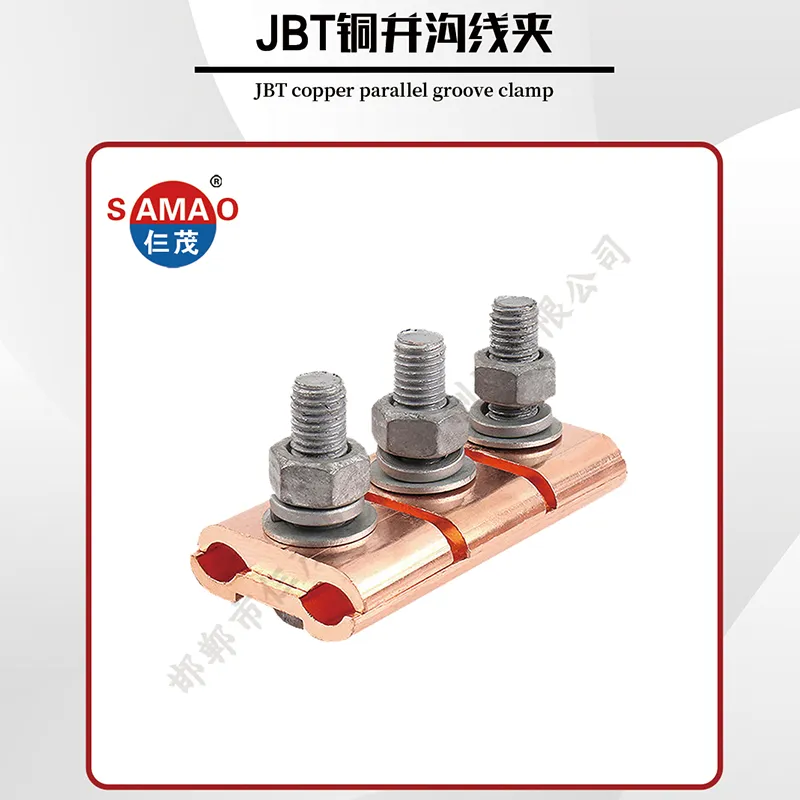
Manufacturer Comparison and Strategic Selection Criteria
When procuring parallel groove clamp solutions for critical infrastructure projects, a thorough evaluation of manufacturers is as vital as scrutinizing product specifications. The market for these components is diverse, ranging from large multinational corporations to specialized local producers, each offering varying levels of product quality, technical support, and pricing structures. A superficial comparison based solely on parallel groove clamp price can lead to significant long-term costs associated with premature failures, increased maintenance, and operational inefficiencies. Therefore, B2B decision-makers and technical personnel must adopt a holistic approach to vendor selection, prioritizing factors that ensure product reliability and project success. Key criteria for evaluating manufacturers include their adherence to international quality management systems (e.g., ISO 9001), their track record of compliance with product-specific standards (e.g., IEC 61284, ANSI C119.4), and their overall reputation within the industry, often reflected in their service longevity and the breadth of their client portfolio. A manufacturer with extensive experience, say over 15-20 years in the field, is likely to possess the accumulated expertise to anticipate and address complex application challenges, translating into more robust and reliable products.
Beyond certifications and experience, the manufacturer's commitment to research and development (R&D) is a strong indicator of their ability to innovate and provide cutting-edge solutions. Manufacturers who consistently invest in R&D are better positioned to offer advanced parallel connectors with improved material properties, enhanced corrosion resistance, and optimized designs for challenging environments or specialized conductors (e.g., high-temperature low-sag conductors). A robust R&D department also implies a deeper understanding of material science, electrical conductivity, and mechanical stresses, leading to products that perform reliably under extreme conditions. Furthermore, the extent of a manufacturer's testing capabilities and their transparency regarding test data are critical. Reputable manufacturers will have in-house laboratories equipped for comprehensive electrical, mechanical, and environmental testing, and they should be willing to provide detailed test reports and type test certificates that validate product performance against international standards. This rigorous testing regimen significantly reduces the risk of field failures and provides assurance regarding the quality of the parallel groove clamp.
Service and support capabilities also play a crucial role in manufacturer comparison. A strong technical support team that can offer pre-sales consultation, assist with product selection, and provide post-sales troubleshooting is invaluable. This includes the ability to offer customized solutions tailored to specific project requirements, which is increasingly important for complex or unique applications. Manufacturers who provide comprehensive warranty periods and readily available spare parts or replacement policies demonstrate confidence in their product quality and a commitment to long-term client satisfaction. Their logistics and delivery capabilities, particularly for large-scale projects, also merit consideration to ensure timely project execution and minimize downtime. Finally, while parallel groove clamp price is a factor, it should be viewed in the context of total cost of ownership (TCO), which includes initial purchase price, installation costs, expected lifespan, maintenance expenses, and the cost of potential failures. A higher initial investment in a superior quality clamp from a reputable manufacturer often results in significant savings over the product's lifespan due to reduced maintenance, lower energy losses, and enhanced system reliability. By carefully weighing these strategic selection criteria, businesses can forge partnerships with manufacturers that deliver not just components, but reliable, long-lasting solutions that contribute to the overall success and resilience of their infrastructure projects.
Customized Solutions and Engineering Support for Parallel Connectors
While standard parallel groove clamp designs cater to a wide range of common applications, the complexity and unique challenges of modern electrical infrastructure projects often necessitate customized solutions and robust engineering support. This is particularly true for highly specialized environments, unconventional conductor configurations, or projects with stringent performance requirements that exceed standard specifications. A reputable manufacturer differentiates itself by its ability to go beyond off-the-shelf products and provide bespoke parallel connector designs that are precisely tailored to the client's unique needs. This process typically begins with in-depth consultation, where the manufacturer's engineering team collaborates closely with the client's technical experts to understand the specific parameters of the application, including conductor types, sizes, material combinations, environmental conditions (e.g., extreme temperatures, corrosive atmospheres, high winds, seismic activity), current loading, and mechanical stress profiles. This collaborative approach ensures that the resulting custom parallel groove clamp is optimally designed for peak performance and longevity in its intended operating environment, a critical factor often overlooked when evaluating the standard parallel groove clamp price.
The customization process may involve modifications to existing clamp designs or the development of entirely new components. This can include:
- Material Modifications: Using specialized alloys for enhanced strength, conductivity, or corrosion resistance beyond standard offerings. For instance, clamps designed for extremely high temperatures or highly corrosive industrial atmospheres may require specific grades of aluminum or unique surface treatments.
- Geometric Adjustments: Tailoring the groove profiles to perfectly match non-standard conductor sizes or shapes (e.g., trapezoidal conductors, specific high-temperature conductors), ensuring maximum contact area and minimal resistance.
- Bolt and Fastener Customization: Implementing specific bolt types (e.g., shear-head for tamper-proof installation, or specialized materials for extreme environments) or torque requirements to suit unique installation challenges.
- Integration of Additional Features: Incorporating features like integrated surge protection, specialized anti-theft mechanisms, or enhanced insulation properties for specific network architectures.
- Specialized Coatings or Compounds: Applying unique anti-oxidant compounds or protective coatings for prolonged performance in exceptionally harsh or polluted environments.
Beyond design and manufacturing, comprehensive engineering support encompasses the provision of detailed technical documentation, including installation guides, maintenance manuals, and performance data sheets specific to the customized product. Manufacturers may also offer on-site technical assistance, training for installation teams, and post-installation support to ensure optimal deployment and long-term performance. This level of partnership is particularly valuable for large-scale projects, where a small design flaw or installation error can have significant financial and operational repercussions. For instance, in a major substation upgrade or a new transmission line project through a challenging terrain, having a manufacturer capable of providing tailor-made parallel groove clamps with validated performance data, coupled with expert guidance throughout the project lifecycle, significantly de-risks the investment. Such dedicated engineering support not only ensures the technical viability of complex projects but also fosters a relationship of trust and collaboration, transforming the manufacturer from a mere supplier into a strategic partner committed to the client's success. The ability to leverage this expertise is often more valuable than a marginal difference in parallel groove clamp price for mission-critical applications.
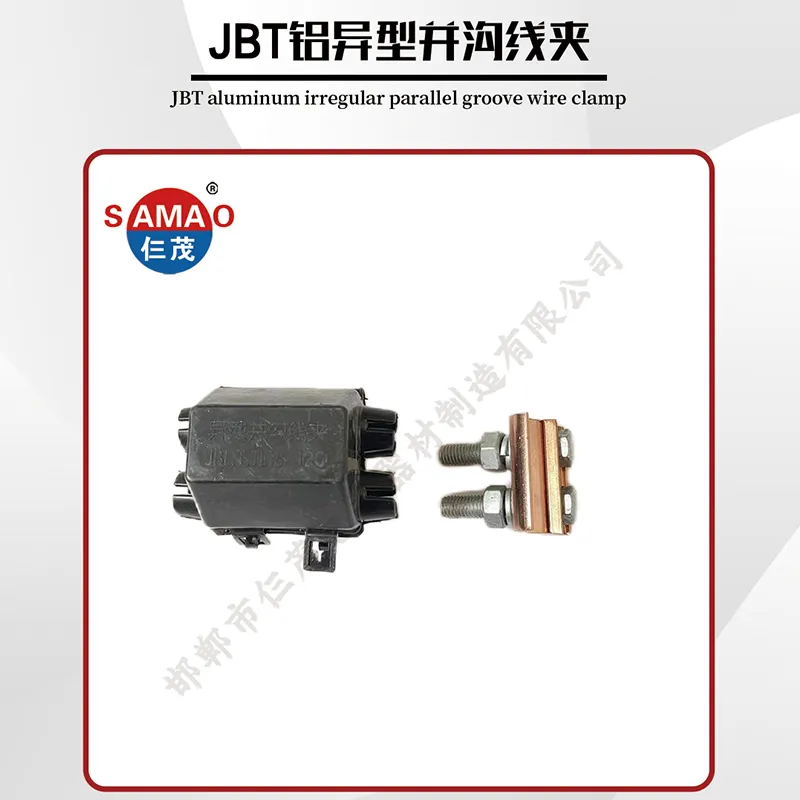
Real-World Application Cases and Performance Validation
The theoretical advantages and stringent manufacturing processes of parallel groove clamp products are best validated through their performance in real-world application cases. Our extensive experience, accumulated over X years (e.g., 20+ years, if applicable for Samao Electric Power), collaborating with leading energy companies, industrial giants, and infrastructure developers globally, provides tangible evidence of the superior performance and reliability of our parallel connectors. For instance, in a major national grid expansion project across a challenging desert terrain, extreme temperature fluctuations (from sub-zero to over 50°C) and persistent sandstorms presented significant challenges for traditional connectors. Our specialized aluminum alloy parallel groove clamps, featuring enhanced creep resistance and a robust sealing mechanism with pre-filled anti-oxidant compound, were deployed across hundreds of kilometers of new transmission lines. Post-installation inspections and thermal imaging surveys consistently demonstrated stable, low-resistance connections, with no signs of overheating or degradation, even after years of operation. This successful deployment resulted in a significant reduction in anticipated energy losses (estimated at 1.5% annually compared to conventional clamps), prolonged the operational lifespan of the connections, and drastically cut down on maintenance requirements, far offsetting the initial parallel groove clamp price premium by ensuring greater grid reliability.
Another compelling case involves a large-scale industrial complex in a highly corrosive coastal environment, where a critical need arose to upgrade the existing grounding system. The challenge was to ensure reliable and long-lasting connections for diverse conductor types, including a mix of copper and aluminum cables, while battling constant salt spray and humidity. Our bimetallic parallel groove clamps with tin-plated copper inserts and specialized corrosion-resistant bolts were selected for this demanding application. The unique design effectively isolated the dissimilar metals, preventing galvanic corrosion, which had been a persistent issue with previous solutions. After five years of continuous operation, detailed site inspections and electrical integrity tests revealed no signs of corrosion or increased contact resistance, even on connections directly exposed to the sea air. The client reported a remarkable improvement in safety protocols and a near-elimination of grounding system failures, showcasing the profound impact of choosing the right parallel connector for challenging environments. This outcome underscores the importance of investing in application-specific engineered solutions, rather than compromising on quality for a lower upfront cost.
Our dedication to quality and performance is further evidenced by ongoing collaborations in the renewable energy sector. In a substantial solar farm project located in a high-wind zone, the mechanical stability of every connection was critical to prevent conductor fatigue and clamp loosening. Our parallel groove clamps, manufactured using precision forging and validated through rigorous vibration and fatigue testing to meet IEC 61284 standards, were chosen for the collector lines. The clamps' robust design and optimized clamping force, ensured by shear-head bolts, proved resilient against sustained wind-induced vibrations, maintaining electrical continuity and mechanical integrity where other clamps had previously failed under similar conditions. This success story not only reaffirmed the superior mechanical properties of our products but also contributed significantly to the solar farm's projected energy output consistency and overall operational reliability, reinforcing our reputation as a trusted provider of high-performance electrical connectors. These diverse case studies exemplify how our commitment to engineering excellence, adherence to strict quality control, and willingness to provide customized solutions translate into tangible benefits for our clients, ensuring robust infrastructure and long-term operational success, regardless of the complexity or harshness of the environment.
Quality Assurance, Certifications, and Industry Authoritativeness
In the demanding landscape of electrical infrastructure, the credibility and reliability of any supplier of parallel groove clamp products hinge critically on their unwavering commitment to quality assurance and their adherence to globally recognized certifications. As a leading manufacturer, our dedication to excellence is deeply embedded in every stage of our operations, from raw material sourcing to final product delivery. Our manufacturing facilities operate under the stringent guidelines of ISO 9001:2015 Quality Management System, ensuring that every process, from design and production to testing and customer service, meets the highest international standards for quality and efficiency. This certification is not merely a formality; it signifies a continuous commitment to improvement, systematic control of processes, and a customer-centric approach that ensures consistent product quality and reliable performance. Furthermore, our products, including every parallel connector we produce, undergo rigorous type testing and routine testing in accordance with pivotal industry standards such as IEC 61284 (Overhead lines – Fittings – Requirements and tests for compression and mechanical connectors), ANSI C119.4 (American National Standard for Connectors for Use in Overhead Distribution Lines), and relevant ASTM (American Society for Testing and Materials) standards for material properties. These certifications and testing regimes provide independent validation of our products' mechanical, electrical, and environmental performance, assuring clients of their suitability for critical applications.
Our authoritativeness in the field is built upon decades of specialized experience and a strong track record of successful project collaborations. With over two decades in the industry, our service history reflects a deep understanding of evolving market needs and technological advancements in electrical connectors. We have fostered long-term partnerships with major utility companies, engineering, procurement, and construction (EPC) firms, and industrial conglomerates across diverse regions, contributing to significant infrastructure projects globally. These collaborations serve as a testament to our product quality and the trust our clients place in our engineering capabilities. Beyond general certifications, many of our specific parallel groove clamp models hold product-specific accreditations or approvals from national grid operators and recognized testing laboratories, further underscoring their compliance with specific market requirements and safety regulations. For example, relevant tests include:
- Cyclic Current Heat-Cycle Test: Simulating thermal expansion and contraction over thousands of cycles to assess long-term electrical stability and resistance.
- Short-Circuit Withstand Test: Verifying the clamp's ability to safely carry high fault currents for short durations without mechanical or electrical failure.
- Vibration Fatigue Test: Simulating prolonged exposure to conductor vibration to ensure mechanical integrity and prevent loosening of connections.
- Corrosion Resistance (Salt Mist/SO2 Test): Evaluating performance in aggressive atmospheric conditions to guarantee product longevity.
Our unwavering adherence to these rigorous standards and our proactive engagement with industry bodies ensure that our parallel groove clamp solutions are not only compliant with current regulations but are also future-proofed against evolving technical demands. This dedication to quality, combined with our extensive service record and strong client testimonials, solidifies our position as an authoritative and trustworthy partner in the global electrical infrastructure supply chain. The superior performance and reliability of our products ultimately lead to a lower total cost of ownership for our clients, despite any initial variations in parallel groove clamp price, by minimizing maintenance requirements, reducing energy losses, and enhancing overall system resilience and safety. Our consistent delivery of high-quality products and comprehensive technical support underlines our commitment to being at the forefront of electrical connector technology, serving as a pillar of reliability for critical power transmission and distribution networks worldwide.
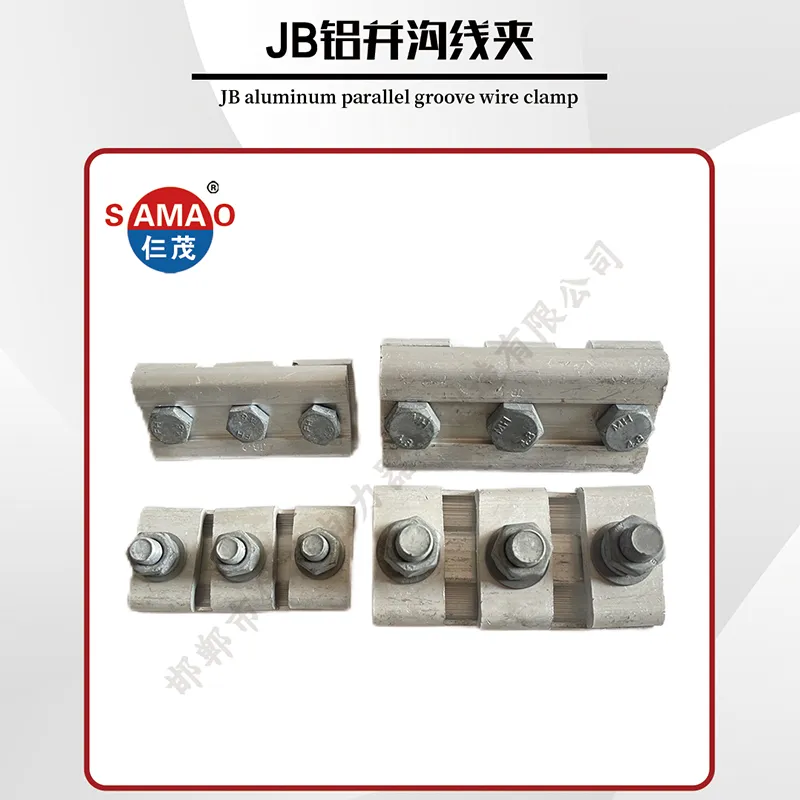
Trustworthiness, Customer Support, and Long-Term Partnership
Building trust in the B2B sector, particularly for critical components like the parallel groove clamp, extends far beyond product specifications and certifications. It encompasses a comprehensive commitment to transparency, reliable support, and a collaborative partnership approach throughout the product lifecycle. Our dedication to trustworthiness is reflected in our proactive communication and comprehensive customer support infrastructure, designed to provide seamless assistance at every touchpoint. We understand that in complex infrastructure projects, clarity regarding product delivery, installation guidance, and post-sales service is paramount. Our standardized delivery cycle ensures that clients receive their parallel connector orders efficiently and predictably, with real-time tracking and dedicated logistics support for large-volume shipments. Typical lead times are communicated upfront, and we maintain robust inventory management to handle both standard orders and urgent requirements, minimizing project delays. Our global distribution network and strategic warehousing facilitate timely delivery to diverse geographical locations, mitigating supply chain risks for our international clientele. This logistical reliability contributes directly to project adherence and helps manage the overall parallel groove clamp price implications by avoiding costly project overruns.
Our commitment to customer satisfaction is further solidified by our comprehensive warranty policy and robust after-sales support. Every parallel groove clamp is backed by a substantial warranty period, affirming our confidence in its durability and performance under specified operating conditions. This warranty covers manufacturing defects and material failures, providing clients with peace of mind and protection for their investment. Beyond the warranty, our technical support team remains available for consultation, troubleshooting, and guidance throughout the product's operational life. This includes expert advice on installation best practices, maintenance schedules, and optimal application scenarios, ensuring that our clamps continue to perform at their peak. We also maintain a readily available stock of common replacement parts and components, ensuring prompt resolution of any unforeseen issues. Client feedback is invaluable to us, and we actively solicit and incorporate it into our product development and service enhancement processes. Testimonials from satisfied clients consistently highlight our responsiveness, technical expertise, and dedication to resolving challenges, reinforcing our reputation as a reliable and trusted partner.
To further enhance trustworthiness and address common inquiries, we provide a detailed FAQ section:
- Q: What is the typical lifespan of your parallel groove clamps?
A: Our parallel groove clamps are engineered for a long service life, typically exceeding 25-30 years under normal operating conditions, due to high-quality materials and rigorous testing. - Q: Are your clamps suitable for bimetallic connections (aluminum to copper)?
A: Yes, we offer specialized bimetallic parallel groove clamps featuring tin-plated copper inserts designed specifically to prevent galvanic corrosion when connecting dissimilar conductors. - Q: Do your products comply with international standards?
A: Absolutely. All our products are manufactured and tested in strict accordance with international standards such as IEC 61284, ANSI C119.4, ISO 9001, and relevant ASTM specifications. - Q: Can you provide customized parallel groove clamp solutions for unique project requirements?
A: Yes, we specialize in providing tailored engineering solutions. Our R&D team works closely with clients to design and produce customized clamps for specific conductor types, environmental challenges, and performance needs. - Q: What is your standard delivery time for large orders?
A: Delivery times vary based on order size and customization. We provide detailed lead times upon quotation and ensure transparent communication and logistical support to meet project schedules.
Conclusion: Securing the Future of Electrical Connectivity
The ubiquitous parallel groove clamp, often seen as a standard component, is in fact a critical engineering marvel whose meticulous design, advanced materials, and stringent manufacturing processes underpin the reliability and efficiency of modern electrical grids and industrial systems worldwide. From high-voltage transmission lines spanning vast distances to intricate grounding systems in petrochemical plants, the performance of these connectors directly impacts energy efficiency, operational safety, and long-term infrastructure resilience. The ongoing trends of grid modernization, the rapid integration of renewable energy sources, and the increasing demand for uninterrupted power supply continue to drive innovation in parallel connector technology, pushing the boundaries of material science, mechanical design, and electrical performance. Manufacturers are constantly refining solutions to offer lower electrical resistance, superior corrosion protection, enhanced mechanical stability, and simplified installation, all while balancing performance with competitive parallel groove clamp price considerations that ultimately contribute to a lower total cost of ownership for end-users.
For B2B decision-makers and technical specialists, selecting the optimal parallel groove clamp goes beyond a simple procurement decision; it is a strategic investment in the longevity and operational integrity of their assets. This requires a comprehensive evaluation of a manufacturer's expertise, evidenced by their adherence to international standards (ISO, IEC, ANSI), their commitment to rigorous testing, and their proven track record in diverse application scenarios. The ability of a supplier to provide customized solutions, coupled with robust engineering support, responsive customer service, and transparent delivery logistics, are equally vital indicators of trustworthiness and a strong potential for long-term partnership. As the global energy landscape continues to evolve, the demand for highly reliable, durable, and technologically advanced electrical connectors will only intensify. By prioritizing quality, performance, and comprehensive support, businesses can ensure that their electrical infrastructure is not only robust enough for today's challenges but also resilient and efficient for the demands of tomorrow. The continuous innovation in parallel groove clamp technology plays a pivotal role in securing the future of electrical connectivity, enabling more sustainable, reliable, and energy-efficient power systems across the globe.
References and Further Reading
- International Electrotechnical Commission (IEC) Standards - Specifically IEC 61284: Overhead lines – Fittings – Requirements and tests for compression and mechanical connectors.
- American National Standards Institute (ANSI) - Reference ANSI C119.4: American National Standard for Connectors for Use in Overhead Distribution Lines.
- Institute of Electrical and Electronics Engineers (IEEE) - Publications on power engineering, conductor sag, and connector performance.
- ASTM International - Standards for material properties and testing methods of electrical conductors and fittings.
- CIGRE (International Council on Large Electric Systems) - Technical brochures and publications on overhead line design and conductor accessories.
-
Strong Hold with Constant Tension Hose ClampsNewsAug.08,2025
-
Smart Power with LV & MV SwitchgearNewsAug.08,2025
-
Smart Connection with Parallel Groove Clamp PriceNewsAug.08,2025
-
Secure Wiring with Overhead Line ClampNewsAug.08,2025
-
Safe Grounding with Earthing Type ElectricalNewsAug.08,2025
-
Power Up with Smart Electrical Equipment TodayNewsAug.08,2025
-
State Grid Sichuan Electric Power's 2023 Provincial Company Agreement Inventory Bidding ProjectNewsNov.21,2024

